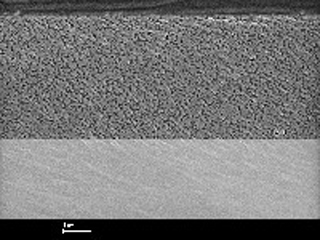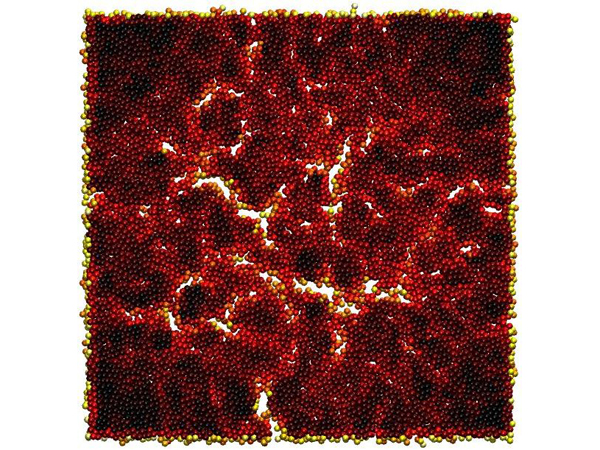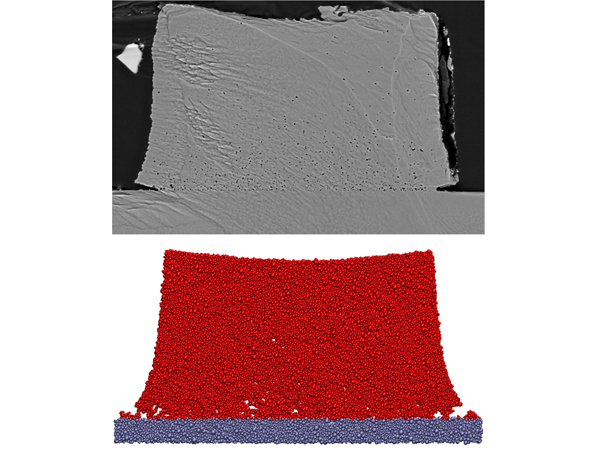Sintering of ceramic layers on rigid substrates
Introduction

Sintering is the concluding stage in the production process for metallic or ceramic components based on powder technology. It involves the densification of the preformed material through thermal activation.
Typical upstream forming methods are pressing or casting processes (e.g. tape casting). The porous microstructure, the so-called green compact, already has the form of the desired component but does not yet have the strength necessary for the intended practical application. In order to achieve this, the green compact is heated, whereupon diffusion processes bring about a migration of the material from the grains of the powder itself into the pores between the grains. This leads to a distinct reduction in volume and at the same time to a densification of the total body of material. This is a cost-effective method for producing accurate components with a high strength.
One special form of sintering is “constrained sintering”. In this method the green compact is applied to a rigid substrate that is not sintered in the sintering process. The result of this is that the radial movement of the component is restricted during the sintering process and the compaction takes place almost exclusively perpendicular to the substrate. This can be exploited in the precise fabrication of thin ceramic films, which are used in multi-layer circuits.
The task

The constrained shrinkage of a thin ceramic coating during sintering, which is due to the substrate, can lead to an anisotropic microstructure and promote the formation of cracks, which in turn can bring about a severe reduction in the service life of the component. An insight into the processes at the powder grain level is indispensable for studying these effects, the causes of which are to be found in the microstructure of the ceramic film.
Owing to its particle-based approach, the SimPARTIX® software suite allows the sintering to be simulated at the powder grain level. Microscopic effects such as particle rearrangement or friction between ceramic particles are taken into account here in a natural way. The development of the microstructure during the sintering process can therefore be simulated and analyzed easily and cost-effectively.
At the Fraunhofer Institute for Mechanics of Materials SimPARTIX® was used to investigate the extent to which the formation and propagation of cracks can be avoided or at least controlled. This work was carried out as part of the Deutsche Forschungsgemeinschaft (DFG) research project Sintering of thin ceramic coatings on rigid substrates (KR 1729/10-1).
To complement this work, the Faculty of Materials & Earth Sciences at Darmstadt TU carried out experiments on constrained sintering. Afterwards, the results of the simulation were compared with and verified by those of the experiments.
Results
SimPARTIX® represents a convenient way of investigating the global and local densification behavior of a thin ceramic coating during the sintering process depending on various parameters such as powder properties, dimensions or rate of temperature rise. It is also possible, with the high-resolution available, to establish the local density in order to determine the zones with lower densities or reveal (hairline) cracks, for example.
Apart from examining the sintering behavior at various temperatures, the studies hitherto also investigated how intergranular friction influences the rearrangement behavior of particles and hence indirectly affects the formation of pores and cracks.
Our analyses have revealed that constrained sintering of thin stripes leads to delamination cracks at the interface edges [Ras12]. Appearance and length of such cracks as well as shape distortion of the stripe cross-section were shown to be affected significantly by the stripe height.
Furthermore, simulations were carried out on specimens with specific defects in order to investigate the extent to which these promote the formation of undesirable cracks.
 Fraunhofer Institute for Mechanics of Materials IWM
Fraunhofer Institute for Mechanics of Materials IWM